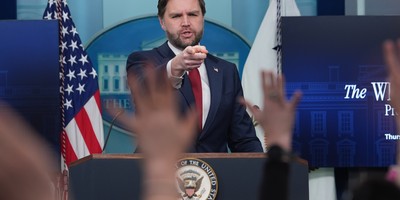 There’s a booming electoral business of pandering to college-educated young voters—and it spells bad news for America.
There’s a booming electoral business of pandering to college-educated young voters—and it spells bad news for America.
From Townhall Magazine's July feature, "Student Groans," by Kevin Glass and Daniel Doherty:
Barack Obama’s win in the 2008 presidential election was boosted by a truly historic youth vote. While young voters have often swung more heavily to Democratic presidential candidates than the general population, the margin by which they preferred Obama in 2008 over his Republican rival John McCain was tremendous. The 18-29 year-old demographic went for Obama by a 2-to-1 margin, bolstered by the rock-star candidacy of a young, energetic, idealistic Democrat.
Ever since the Department of Education was founded by President Jimmy Carter, it’s been a Democratic public policy priority to push subsidized postsecondary education to an ever-wider section of the American people. America’s idealistic youth are only too happy to be bought off by promises of easy money for college by the government.
In an election year that will see the youth vote surprisingly vulnerable to capture by Republicans thanks to unemployed young adults, both parties will be playing hardball with policies tailored to young people. Unfortunately, most federal education policies amount to little more than taxpayer money spent to no one’s benefit.
Exit polls conducted by NBC News showed that it wasn’t necessarily the size of the youth vote that mattered—which was almost unchanged from 2004 to 2008—but the strength by which they preferred Obama to McCain. Young voters favored Obama by 13 points more than the general population did, which is more than twice the preference that the young vote has ever swung for a Democrat in a general election. According to the Edison/Mitofsky National Exit Polls, the share of the youth vote obtained by Obama is by far the most that any candidate has garnered in the history of exit polling.
Much has changed since 2008. There’s a wide perception on the part of progressives that President Obama hasn’t done enough to cater to the lofty hopes and dreams that candidate Obama aspired to. The incumbent president’s lead over his Republican rival in the youngest demographic has been in the single digits. The fervency of young support has cratered: an NBC/Wall Street Journal poll revealed that a quarter of young voters who expressed “high” interest in 2008 have since lost that level of enthusiasm.
Youth voters turning their backs on President Obama could result in a national popular vote loss of up to 2 percent for the president. That’s not enough on its own to undo the margin that existed in 2008 but, coupled with a broader movement, could spell the end of Obama’s tenure in the White House. He doesn’t want to lose the power that the youth vote brought him in 2008.
In the economy’s sluggish recovery, youth unemployment is at 16.4 percent. Recent college graduates have faced a paucity of jobs and unemployment rates higher during President Obama’s tenure than the national average, though that statistic is not necessarily unique to Obama’s presidency. The Economic Policy Institute, a liberal think tank, estimates that the number of “unemployed or underemployed” college graduates is over 50 percent. The president has done little to alleviate the problems facing young adults in America, and his proposed solutions aren’t the panacea he has made them out to be.
President Obama has suggested the solution to the hardships young people—and recent college graduates—face in an economic downturn is to send more of them to school. In his 2012 State of the Union speech, Obama said, “Higher education can’t be a luxury. It’s an economic imperative that every family in America should be able to afford.” He’s advocated more aggressive government subsidies for college while completely ignoring the role that the federal government has played in making higher education more expensive and the role that government spending has in inflating a massive student loan bubble.
The 2008 motto, “Hope and Change,” that Obama ran on might have inadvertently saddled him with a base that believed he was going to upend the entire political system. As a result, he was judged by everything he didn’t do, not everything he did. In particular, some recent college grads saddled with student loan debt and a struggling economy appear to blame the president. The Occupy Wall Street crowd, which coalesced in part around advocating complete forgiveness of student loan debt, only exacerbated these tensions. What these young idealists have missed are the myriad ways in which the president has been using taxpayer money to pander to the youth vote.
The Takeover
Hidden inside of the monstrous legislation known as ObamaCare was a near-total government takeover of student loan lending. Student loans used to be made by private lenders with a government guarantee. However, in 2007, Democrats in Congress mandated that private lenders make loans at an unsustainably low interest rate, which caused private lenders to shy away from the industry. Because of this, the Department of Education began to act as a middleman, buying loans at lower rates and then distributing them to students. While this was meant to be a temporary measure, the Obama administration decided to make the middleman—government—the primary lender, cutting out private business.
Recommended
While this happened mostly in the background, the obvious result is that students are able to take out loans at below-market rates—in effect, a government subsidy for their education.
That 2007 rate cut has come front and center in the presidential campaign this year. Always meant to be temporary, the rate cut is now being trumped up by Obama as an important policy goal. Throughout April and May, Obama visited college campuses across the country touting the interest rate cuts he has proposed. At major universities in swing states, President Obama has stumped on spending an extra $6 billion per year to keep the Stafford loan program at artificially low interest rates. How does he plan to pay for this? With more public debt.
Obama has asserted ad nauseam in recent speeches that increasing interest rates on government-subsidized Stafford loans will adversely affect college students. The one he gave at the University of Iowa last April is a good example of how misleading his rhetoric has been on the subject.
“For each year that Congress doesn’t act,” the president informed a crowd of energetic undergraduates, “the average student with these loans will rack up an additional $1,000 in debt. … How many people can afford to pay an extra $1,000 right now?”
The students in attendance, not unexpectedly, were receptive to the president’s populist messaging. After all, how many pending graduates look forward to incurring more student debt? However, a closer look at the numbers—and specifically at the fact that only a small percentage of students will be affected by congressional inaction— shows it’s painfully evident President Obama is playing politics to win over young voters.
The White House contends that keeping subsidized Stafford loan interest rates at 3.4 percent for another year would result in about $1,000 in savings. This is true, of course, if one assumes the average student loan is $4,200 and extends over a 12-year repayment period. But, as Minnesota Public Radio News’ Catherine Richert recently discovered, President Obama’s own 2013 budget pegs the average Stafford loan at $3,400 over a 10-year repayment period. This translates roughly into $524 over the life of a loan, or only about half of what the administration is peddling.
Even so, not everyone agrees with the White House projections. Frederick Hess, director of Education Policy Studies at the American Enterprise Institute, estimated failing to extend the lower rate would cost the average borrower “about $25 per month,” according to National Review. Former Congressional Budget Office (CBO) Director Douglas Holtz-Eakin went further than that, arguing in National Review that the difference would only amount to $7 per month.
There are 39 million Americans with student loan debt, and 9.5 million of those are on the Stafford loan program. In other words, the interest rate extension affects less than 25 percent of total borrowers. And considering the average student with subsidized Stafford loans finishes college $13,000 in debt (which is $12,000 less than the national average), these individuals are demonstrably better off than their fellow graduates. Remember, too, a rate hike would only affect students who take out subsidized Stafford loans after July 1, 2012; interest rates on existing loans would not change.
The fact is, though, the cost of freezing interest rates at 3.4 percent is projected to add $30 billion to the national deficit over the next five years. At a time when, according to the nonpartisan CBO, the federal government borrows 36 cents out of every dollar it spends, appropriating more money to pay for another entitlement is not only fiscally irresponsible but a waste of taxpayer dollars.
Pell Grants Are No Fairy-Tale Solution
... Want to read more of Kevin Glass and Daniel Doherty's feature? Subscribe and get the July issue of Townhall Magazine. Remember, our print features are exclusive ... most won't run in full online!

























Join the conversation as a VIP Member